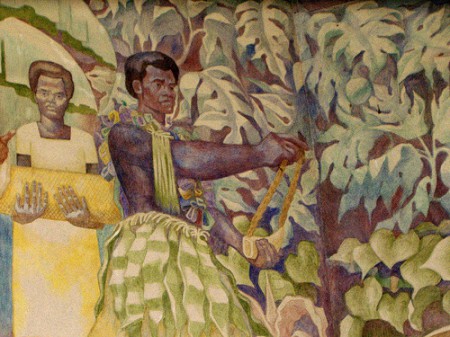- First of all, I need a cup of coffee.
- Stop Press: Britain’s orchards neglected. Prince Charles to be called in to help?
- Eating the wild, in San Francisco and San Diego.
- IFAD on what African farmers need: infrastructure, insurance, investment. Apparently.
- Harvesting sesame in Greece: The video.
- Filipinos make wine from Hawaiian traditional food. Strange the Hawaiians hadn’t thought of that. But perhaps they did.
- And while we’re on the subject of booze…
- Destroying the Pantanal and Cerrado in a sustainable manner.
- Hey, it’s Hemp History Week! And you know how to celebrate that, don’t you.
Nibbles: Fair mangoes, Rice domestication, Saline collections, Spice collections, Aquaculture, Salmon
- Fair trade Haitian mangoes hit the shelves.
- Molecular boffins use nifty new toys to re-write rice history. Until the next time.
- The genebank of the International Centre for Biosaline Agriculture in Dubai has found material suitable for, ahem, saline agriculture.
- The genebank of the Indian Institute of Spices Research in Calicut has a large collection of, ahem, spices.
- The downside of tilapia.
- And, speaking of fish, it’s not all bad news.
Nibbles: GBIF, Grains, Sorghum, Carnival, ECP/GR, Rabbits, Conference, Satoyama
- The evolution of the GBIF registry. If you need to ask, you don’t need to know. And if you don’t, you do.
- US farmers encouraged to try millets, sorghum — for birds. …
- … while in Kenya, Farmers turn to sorghum to boost their food security. They’re eating their beer.
- The latest Berry go Round blog carnival is up at Foothills Fancies. I liked the Red Filbert.
- The European Cooperative Programme for Plant Genetic Resources, known to its friends as ecp/gr, has a spiffy new website. But no RSS feed, so it’s unlikely we’ll be bringing you anything else of interest from that site.
- Battery rabbits back on the menu in England? A warren of contradictions, I tell you.
- International Conference on In Situ/On farm conservation and use of agrobiodiversity (fruit crops and wild fruit species) in Central Asia, 23-26 August, in Tashkent. Programme PDF here.
- “Japan should look to satoyama and satoumi for inspiration.” I thought it already had …
Breadfruit roundup
Our friend Diane Ragone of the Breadfruit Institute has kindly reminded us that there’s been quite a lot published on her favourite fruit lately. Almost worth a Brainfood all on its own, in fact.
Beyond the Bounty: Breadfruit (Artocarpus altilis) for food security and novel foods in the 21st Century. Great potential, but “a deeper understanding of the nutritional characteristics and the development of new products and markets are needed.” Which is kinda provided, at least to some extent, by the next two papers.
Diversity of breadfruit (Artocarpus altilis, Moraceae) seasonality: A resource for year-round nutrition. “About 24 cultivars exhibited very little seasonality and produced fruit throughout the year. The rest of the cultivars could be clustered into seasonality groups with characteristic fruiting patterns.”
Nutritional and morphological diversity of breadfruit (Artocarpus, Moraceae): Identification of elite cultivars for food security. “…individual varieties … are particularly good sources of mineral and protein nutrition.”
Nuts
I’ve been kinda quiet lately due to illness last week and then going on vacation to Athens for a few days earlier this week. Here’s a taster of the holiday snaps. More later, on an agrobiodiversity theme, of course.
Oh, and happy Earth Day!

